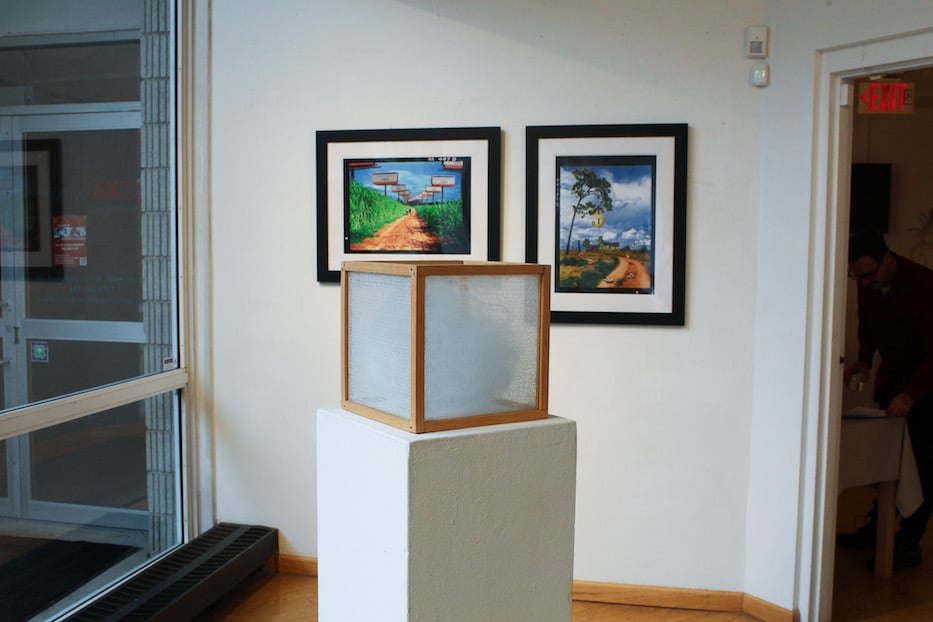
Esthea Kim's cube and two photocollages from the artist Ed Gendron. Blocks and Bridges: World Building in New Haven runs Sept. 25 to Oct. 29 at Creative Arts Workshop at 80 Audubon St. in New Haven. Kapp Singer Photos.
A man wearing overalls and a horse without a saddle amble down a rutted dirt road. Towering corn stalks form a wall to their left. A stand of conifers lie on the horizon.
Some parts of this world are more believable than others. The sky above is the color of blue-raspberry candy. The man casts a shadow but the horse does not. Over a dozen huge billboards, elevated high in the air, line either side of the path. They each display the same thing: a Windows 95 dialog box with the message “An error occurred while displaying the previous error.”
This image is one in a series of photocollages by the artist Ed Gendron in Blocks and Bridges: World Building in New Haven, which runs Sept. 25 to Oct. 29 at Creative Arts Workshop (CAW) on 80 Audubon St. Curated by Gabriel Sacco and organized by Artspace New Haven, the show uses CAW’s Audubon Street space as a gallery after Artspace closed its own brick-and-mortar location on Orange Street in June.
Six local artists—Gendron, Esthea Kim, Jihyun Lee, MO, Pat Garcia, and Gerald Saladyga—make up the show, with work across a variety of media, from painting to sculpture to documentary film. Displayed in CAW’s first-floor gallery, the pieces reinterpret the past and imagine new futures.
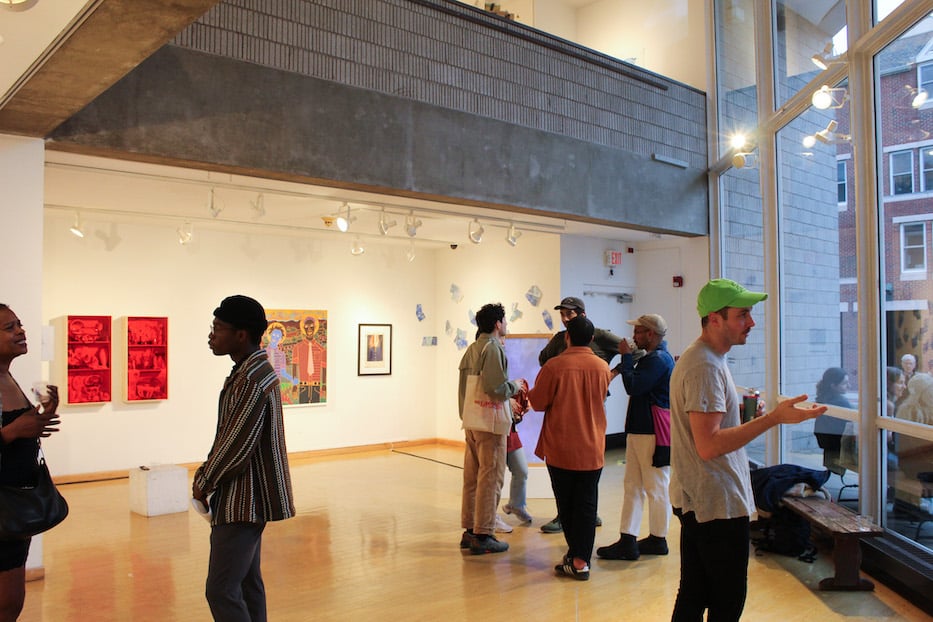
Artists and attendees at an opening reception last weekend. The show runs through Oct. 29.
"World building is a mechanism to generate fictions in a time of political, economic, and social uncertainty and brings these artists in conversation with each other over this common practice," read a press release accompanying the show.
Next to the cornfield scene hangs another window into Gendron’s surreal world. In this collage, entitled The Last Money Tree, a road curves left around a tall pine. Off the tree’s branches hangs a huge golden dollar sign. Several smaller ones—fallen like apples—dot the ground. It’s weird, cheesy, funny, and astute.
To make these scenes, Gendron collects Works Progress Administration photographs from the 1930s and 1940s, scans them into Photoshop, and digitally manipulates them. He leaves the black border of the original photographic negatives, adorned with handwritten notes, in his final compositions. They remind the viewer that, before being digitally transformed into strange new worlds, these were once physical photographs taken by real people.
“I like the viewer to think of them as objects,” Gendron said.
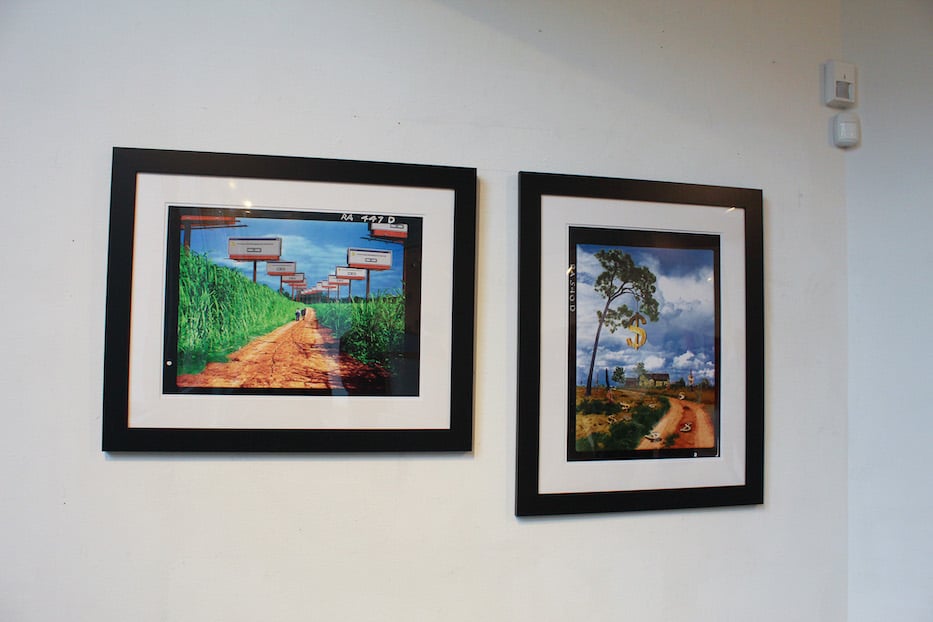
Gendron's work.
Recently, the artist has also been experimenting with AI as an image editing method. He used it to generate the dollar signs in The Last Money Tree. “I have some of the same trepidations [as other artists],” he noted about the technology—many workers in creative industries have been vocal about the threats AI poses to their jobs. But he doesn’t intend to use AI to create pieces wholesale. Instead, Gendron explained, “I use it in a way that’s not so different from collage.”
Across the gallery, two large shelves mounted to the wall form the base of Jihyun Lee’s sculpture Doll Shelf_Red Scene 4, 5. The unpainted plywood cases are filled with hand-sewn figurines, small sketches and doodles, embroideries, and other tchotchkes and ephemera. Each of these objects speaks to a childhood memory—memories that Lee herself recalls from growing up in Seoul, South Korea, but also those of her mother and her son.
"They remind me of our family time and all our conversations,” Lee said at an opening last Saturday. A brass brooch in the shape of a dove sits atop a jar of buttons. Spools of thread surround a miniature ceramic seal. An abstractly painted plate is mounted on the back of the shelf, and a fabric model in the vague likeness of a dog leans against a vertically tilted basket.
The artist has even included small drawings that her son made. Together, these densely packed artifacts evoke a sort of multigenerational Kunstkammer, or "cabinet of curiosities," an early modern museum display technique which involved placing many different and often disparate artworks or specimens in close proximity.
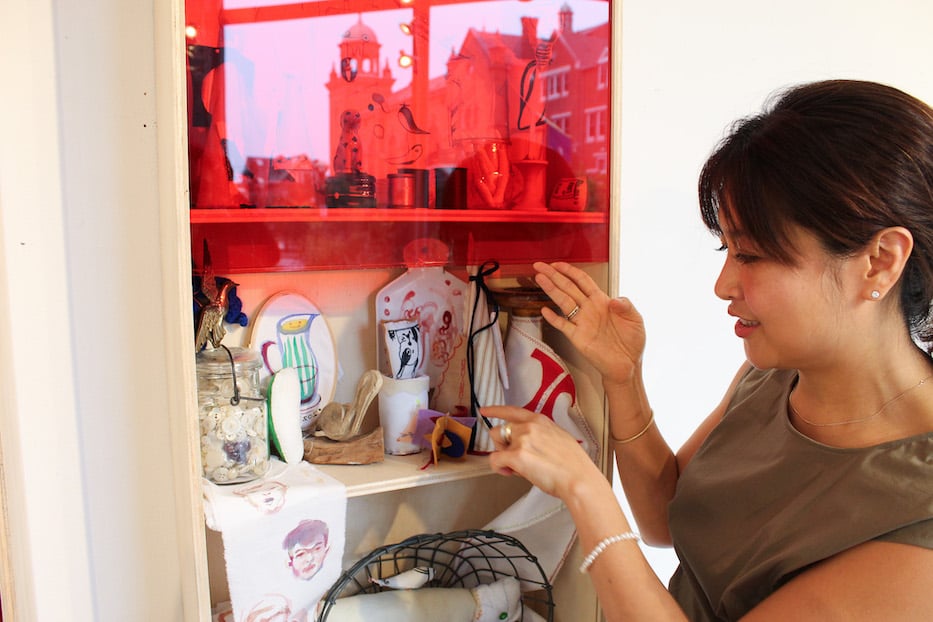
Artist Jihyun Lee with her work.
The shelves are enclosed by large panes of transparent red plexiglass, perhaps the most striking aspect of the work. This element is a reference to the high-gloss red cabinetry in Lee’s mother’s kitchen. She was infatuated with these cabinets—how they would reflect the interior of her childhood home—and when she thinks back on her youth, she imagines it cast over with this warm tint.
For over a decade, Lee has been using this shade of red as an organizing theme for her artwork, first beginning with her painting Red Scene (2012) and then transitioning to sculpture. “I want my art to slice through different private spaces in my mind,” she said as she pulled up the plexiglass panel to reveal the mass of objects behind it.
The red glow of Lee’s shelves is balanced out by the cool tones emanating from Esthea Kim’s two sculptures Cube and Fathom. Kim’s sculptures are formally quite similar to Lee’s—both are wood-framed rectangular prisms sheathed in plexiglass—but while the former creates an atmosphere of memory, the latter, it would seem, seeks to memorialize the atmosphere. Filled with air filters and utility liners, Cube and Fathom look as if they contain clouds.
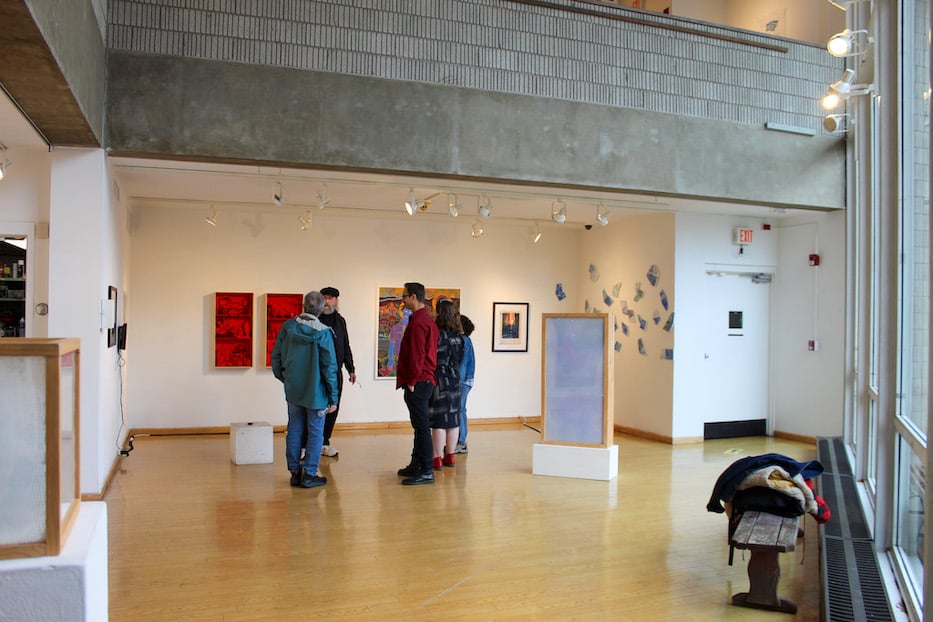
Kim has cleverly transformed everyday materials used for indoor climate control into compelling visual metaphors. These pieces beg the audienceto consider the artificial division between indoors and outdoors made possible by modern building technology.
The sculptures seem to speak to a lineage of sculptural attempts to make visible the ephemeral nature of the air, such as works by Fujiko Nakaya or Judy Chicago. Viewing Kim’s work the day after large floods struck the tri-state area, it was impossible not to read it in the context of the increasingly violent storms being wrought by global warming.
Whether it be Gendron’s reinterpretation of archival photographs, Lee’s dense catalog of memories, or Kim’s reflections on a changing atmosphere, we see that to imagine new worlds does not mean shying away from the past or the present. Counterintuitively, perhaps, Blocks and Bridges: Worldbuilding in New Haven calls us to think critically about life today. Then we can go on to imagine something new, something better.